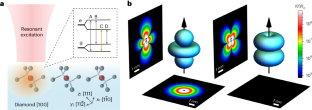Science Daily June 10, 2024
A resonantly excited atomic optical dipole simultaneously generates propagating (far) and evanescent (near) electromagnetic fields. The near-field component diverges in the limit of decreasing distance, indicating an optical antenna with the potential for enormous near-field intensity enhancement. In principle, any atomic optical dipole in a solid can serve as an optical antenna; however, most of them suffer from environmentally induced decoherence that largely mitigates field enhancement. An international team of researchers (USA – University of Chicago, Argonne National Laboratory, Spain) demonstrated that germanium vacancy centres in diamond are exemplary antennas. They measured up to million-fold optical intensity enhancement in the near-field of resonantly excited germanium vacancies. They used germanium vacancy antennas to detect and control the charge state of nearby carbon vacancies and generated measurable fluorescence from individual vacancies through resonance energy transfer. According to the researchers atomic antennas in the solid state promise to yield interesting new applications in spectroscopy, sensing and quantum science… read more. TECHNICAL ARTICLE

The GeV as an antenna.
Credit: Nature Photonics, 07 June 2024